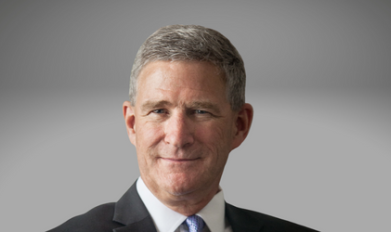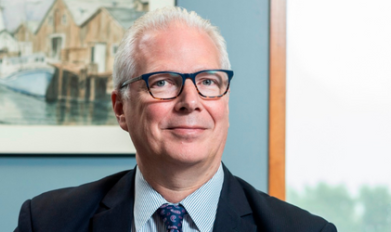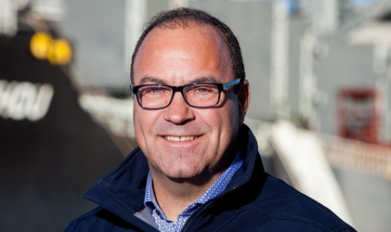Andrea Forbes-Hurley interviews Lydia Bugden, CEO and Managing Partner of Stewart McKelvey, to gain insight into how high-impact Atlantic Canadian organizations are optimizing the potential of people to contribute to the region’s growth and prosperity and to discuss how strengthening our workforce can enhance our economic outlook.
Lydia Bugden is CEO and Managing Partner of Stewart McKelvey, one of the largest law firms in Canada, with more than 200 lawyers and six locations across the Atlantic region. Having taken a unique path to her current role through placements with the TDL Group Ltd. and the forerunner to Enbridge Gas Distribution, Bugden reflects on the value of forging your own path to leadership, how technology has impacted workflow and client delivery in the professional services sector and why Atlantic Canada’s cities are well placed to win the war for talent.
Q: What changes or opportunities have stood out for you in the region over the past five to ten years?
A: There has been a lot of excitement about the ocean sector, which reminds me of the natural gas discoveries of the ‘90s. I think we learned a lot from that experience, to the point where you hear people saying, “How do we capitalize on this as a region?” Look at the Ocean Supercluster, for example. You’re seeing universities, businesses and public and private sector stakeholders working together to make things happen. That is a dramatic change.
For our firm, there are fewer barriers dictating where we can practice. That used to serve as a bit of a protective cover, ensuring clients and law firms from outside the region would engage local law firms when conducting business in Atlantic Canada. Now, with changes to law society mobility rules, they no longer need to do that. You could see that as a negative in that it could lead to more competition here, but it is also a positive in that it encourages and enables us to look beyond Atlantic Canada for opportunities.
Q: What are some of the challenges we face as a region that keep you up at night?
A: The main thing on my mind is the challenges our longstanding clients are facing and how that will impact both their future and ours. We have seen Atlantic Canadian businesses consolidate in recent years, often outside of the region, and when that happens, there is usually a professional firm that loses out. Our goal is to always demonstrate our value as a trusted advisor, which means building expertise and demonstrating to our clients that we can work on a national scale. I think many Atlantic Canadian professional services firms have the capability to do this. We just need to grow where the opportunities take us and develop a portfolio that is not solely Atlantic Canadian specific.
Q: Some suggest this is an age of disruption for industries and business models, particularly due to technological advancements. What’s your take on this thinking?
A: It’s a double-edged sword. Technology facilitates business initiatives, but if you are not careful in how you use it, it can detract from your client relationships. We spend a lot of time reminding our younger lawyers that, despite having access to all this technology, relationships are important in our profession, particularly in a small market like this where you see clients in so many different settings every day. The more you work on building those relationships, the more you can build your practice.
Q: How are these changes and challenges having an impact on the workforce in your profession?
A: There has been a focus on practice innovation in recent years. The first iteration was using technological tools to enhance many of the steps involved in client interactions and standardize document assembly, but it has evolved to the point where we are using technology to compete for new retainers, i.e responding to RFPs, engage with clients on budgets, pricing and legal project management throughout their mandate, and allowing clients to make better decisions.
That has had positive impact on us, but it is a disruptor in the sense that there are new norms that dictate how new and longstanding lawyers will practice, and that means retraining and retooling our workforce. Moreover, RFPs now require a certain degree of technological capability or certification, and there are major issues such as cybersecurity that can only be handled by a relatively robust and dedicated IT team. We are fortunate at Stewart McKelvey because we have the necessary size and resources to stay on top of the ever-changing IT landscape. Not every firm in this region has the resources to dedicate to these issues.
Q: Are you seeing shifting expectations in the incoming generation, and how is that impacting attraction and retention efforts?
A: Like most professional services, the law is rooted in an apprentice-based model and, despite technological advances, there are still considerable time-on-task requirements. But I am seeing an expectation among new generations that they will not spend as much time on task because they can find everything they need using technology. That presents a challenge for us in terms of how we interact with and delegate work amongst the team.
Another change is that many of the lawyers entering the workforce are a little bit older than I was when I came out of law school. They often have young families, mortgages and other debts beyond their student loans. Devoting a couple of years to learning the trade is more of a sacrifice for them than it was for me, so we are trying to find ways to accommodate them. We are also addressing the fact that young lawyers have a greater need for feedback and a desire to act on that. And it has become clear that there is no one path that every lawyer must or wants to be on – not everyone wants to become a Partner, and that’s okay – so we need to look at other opportunities for our workforce to succeed.
Q: In that light, what steps have you taken to address employee expectations and enhance employee retention?
For one, we are ensuring that our people feel valued. We have a Senior Associates’ Summit where we talk about what it means to be a Partner and we run a boot camp with our junior lawyers. The conversations are different for each, but the goal is the same – helping them understand that they are part of something more than their individual practice.
We have also invested in Feedback Matters, a custom-designed tech product we created in-house to help us transform the evaluation process into a dynamic loop between lawyers and associates and facilitate ongoing feedback and professional success. It is still early stages, but it has encouraged more dialogue and that will improve our retention rates.
Another step we are taking is a planned relocation to a new, more collaborative office space. Our hope is that it will be a comfortable spot that encourages everyone to spend time together and collaborate across functions and practice areas. That’s another way for us to ensure that everyone feels like they are part of something more than their individual practice.
Q: As the first woman to become CEO of a major law firm in Atlantic Canada, what advice would you give to women who want to follow in your footsteps and lead an organization?
A: Don’t count yourself out too soon in the game. There’s a statistic out there to the effect that a man will apply for a job if he has 60 per cent of the qualifications, but a woman would need 110 per cent before she would even think of doing it. I think that is often related in part to a sense of self-doubt over ‘Can I juggle that with family and other commitments?’
Also, keep in mind, your path to be a CEO does not have to be the same as anyone else’s. Two of my partners were called to the bar at the same time as I was, but instead of going into a law firm as they did, I served as in-house counsel. When I joined Stewart McKelvey, they were already partners and I was a senior associate, but I went on to become a partner, I took on various managerial roles and then assumed the role of CEO. I would not look back on that and change a thing because I still found my way to where I wanted to go. I think we get too wrapped up too often in what someone else is doing rather than finding our own way forward.
Q: What can employers do to encourage more women to pursue leadership roles?
A: I think they need to be more upfront about these discussions around families and paths. The law has not changed with regard to what you are allowed to ask an employee around family planning, but you can signal that you are open for conversations so that an employee can express the fact that she wants to have a family but also stay with your firm and put herself on a path to leadership. That creates an opportunity to explore options.
It’s also important to open more paths for business development. I remember when a lot of business development centered on sporting events, i.e. on the golf course. That was never a sport I was interested in. Happily, there’s less emphasis on sport now, but employers need to be more open in terms of how they approach business development opportunities. Even so, it ultimately comes down to the individual to express interest in leadership and put themselves on a path, whether they are a male or a female. You don’t have to be aggressive in pursuing it, but you can’t be passive and expect someone to offer you an opportunity. You need to chart your own course. That is what distinguishes a true professional.
Q: If you step back and look at the private sector as a whole, what have been some common denominators that contributed to the survival and success of Atlantic Canadian firms?
A: Perhaps the most important thing is a willingness to look for what’s next. You can’t rest on your laurels thinking you can maintain market share. You’re going to have to grow. You’re going to have to look for different types of talent than you did 15 years ago. You must be looking forward, which is easier said than done.
In saying that, you have to be careful not to follow every new trend. For example, I was determined that, in moving our Halifax office, we would not adopt the “hoteling” model if that deterred people from coming to the office and spending valuable time together. That wave has sort of waned a bit, but it demonstrates that you need to see where or how you fit into that next great thing before pursuing it.
Q: In light of all we’ve talked about, what’s your prediction for the defining changes that will occur in Atlantic Canada’s workforce over the next five to 10 years?
A: I think we are on the cusp of attracting our brightest minds back to the region or keeping them here in increasing numbers. There is a growing buzz about living and working in Canada’s smaller cities, which contrasts with the attitudes when I came out of law school. I think Halifax, for example, has always been a fine small city and I believe it can be a great city if we invest more in recreational opportunities, business innovation, transportation, and our sense of safety. You can see that starting to happen. All we need is to continue to expect, and support, forward thinking from our business and political leaders.
About Atlantic Leader Insights
Atlantic Canada’s economy is fueled by a diverse array of private and public sector entities that employ thousands of people and contribute to our region’s growth and prosperity. But how are these organizations optimizing the potential of their people, and what insights have they gained about the future of our economy from their innovative initiatives?
KBRS recognizes the critical importance of attracting, developing and retaining inspiring leaders and top talent within Atlantic Canada. We sat down with leaders at several high-impact Atlantic Canadian organizations to talk about our region’s opportunities and challenges. This article is one in a series that aims to collect these leaders’ insights on how we can enhance our economic outlook by strengthening our workforce.

CEO and Managing Partner, Stewart McKelvey




















